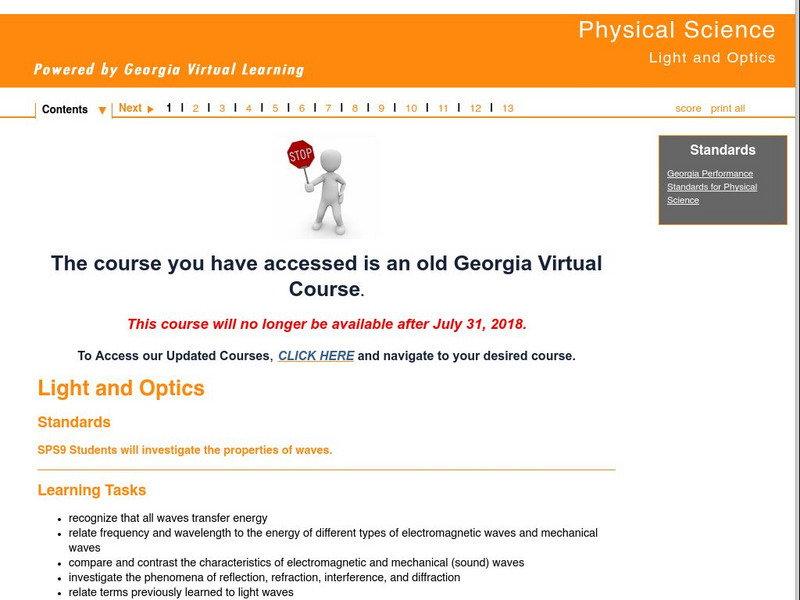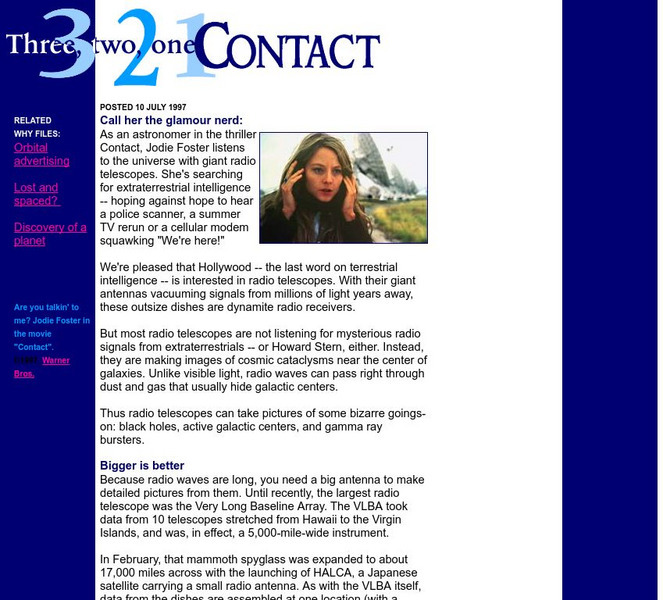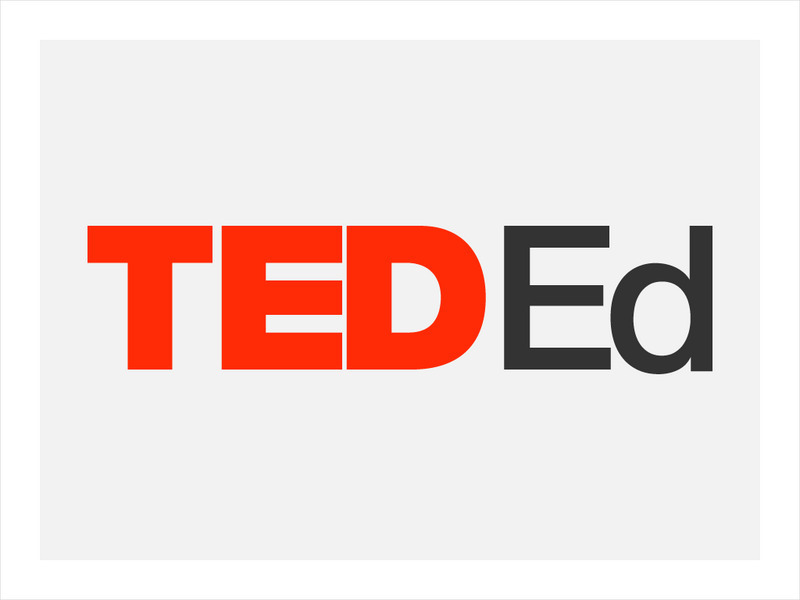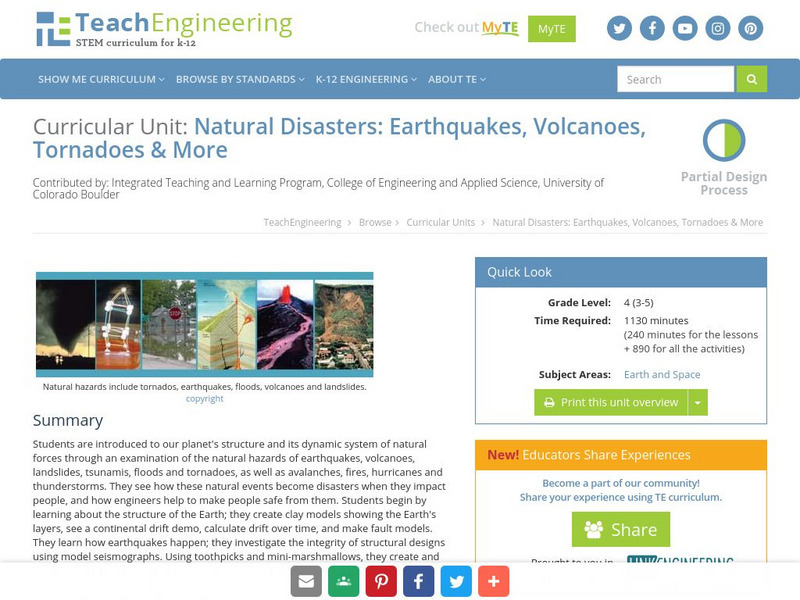Georgia Department of Education
Ga Virtual Learning: Physical Science: Light and Optics
Students will investigate the properties of light waves. They will learn about the different types of electromagnetic waves and mechanical waves, and investigate the phenomena of reflection, refraction, interference, and diffraction.
PBS
Nova: Seismic Signals
Scientists have determined that the earthquakes preceding volcanic eruptions are different than those that precede earthquakes. Discover the sounds and wave patterns produced by the three different types of volcanic seismic activities.
National Weather Service
National Weather Service: Weather Fatality, Injury and Damage Statistics
Web site that contains detailed statistics involving natural disasters by year and type of disaster. Statistics are available in .pdf format.
TeachEngineering
Teach Engineering: Beating the Motion Sensor
Lighting is responsible for nearly one-third of the electricity use in buildings. One of the best ways to conserve energy is to make sure the lights are turned off when no one is in a room. This process can be automated using motion...
Math Science Nucleus
I. Science Ma Te: Integrating Science, Math and Technology
This site offers a wealth of online textbook-related materials that encourage the discovery of science in the world around us. Enter the site to access material on specific topics. Each section contains reading material (complete with...
TeachEngineering
Teach Engineering: Energy
Through nine lessons, students are introduced to a range of energy types--electrical, light, sound and thermal-as well as the renewable energy sources of wind, hydro (water) and solar power. Subjects range from understanding that the...
Oak Ridge National Laboratory
Human Genome Project: Unearthing Buckyballs
Resource provides great information on buckyballs. Description of a process to identify and determine the size and type of fullerenes. Excellent movie on basic fullerene information. Pictures are also included for further information....
TeachEngineering
Teach Engineering: Light It Up
Through an introduction to the design of lighting systems and the electromagnetic spectrum, students learn about the concept of daylighting as well as two types of light bulbs (lamps) often used in energy-efficient lighting design....
ClassFlow
Class Flow: Electromagnetic Spectrum
[Free Registration/Login Required] In this Flipchart, students are introduced to the electromagnetic spectrum. Students will learn the names of the types of waves, and the order in which they are arranged. Additionally, students will...
Geography 4 kids
Geography4 kids.com: Shortwave and Longwave Radiation
Understand the two types of waves featured within this text.
University of Wisconsin
The Why Files: 3 2 1 Contact, Don't Touch That Dial
A discussion of reflecting telescopes and their use in radio astronomy. The types of information gained from and the research emphasis fueled by such telescopes is described. Site uses Hollywood references and a humorous style.
Concord Consortium
Concord Consortium: Quantum Tunneling
Delve into a microscopic world working with models that show how electron waves can tunnel through certain types of barriers. Learn about the novel devices and apparatuses that have been invented using this concept. Discover how...
CK-12 Foundation
Ck 12: Earth Science: Landforms From Erosion and Deposition Study Guide
[Free Registration/Login may be required to access all resource tools.] Summarizes the key points about the six types of erosion and deposition that create Earth's landforms. Includes a few questions to check for understanding.
Science Buddies
Science Buddies: Set Your Table for a Sweet and Sticky Earthquake Shake
Earthquakes can have different affects depending on their location. This week long exercise asks you to build a model house and a special table to shake it on, and see how different soil types can amplify shaking.
Alabama Learning Exchange
Alex: Understanding Solar Energy. Part 1
This lesson discusses how electromagnetic radiation transfer the sun's energy to earth. This lesson will also talk about the eight types of electromagnetic waves in the electromagnetic spectrum and how each type is used or found in our...
Energy4Me
Energy4me: Name That Tune
Students will learn that scientists use seismic technology (sound waves) to map patterns of rock formations below the surface of the earth and that different types of rocks affect sound waves.
Other
Synthesis Definitions
Includes all different types of synthesis, including FM, additive, AM, subtractive, granular, RM, and wavetable.
TeachEngineering
Teach Engineering: Audio Engineers: Sound Weavers
In this activity, students are introduced to audio engineers. They discover in what type of an environment audio engineers work and exactly what they do on a day-to-day basis. Students come to realize that audio engineers help produce...
Space Telescope Science Institute
Amazing Space: Star Light Star Bright: Electromagnetic Radiation
Use this tool to learn facts about the range of the electromagnetic spectrum, from radio waves to gamma rays.
TED Talks
Ted: Ted Ed: Will Future Spacecraft Fit in Our Pockets?
When you picture a rocket, you might imagine a giant ship carrying lots of fuel, people and supplies. But what if the next wave of spacecraft were small enough to fit into our pockets? Dhonam Pemba details the future of microspacecraft,...
Curated OER
P and S Waves
A description of the different types of earthquake waves that features graphics and explanations accompanied by video interview with an expert in the field.
Curated OER
Rayleigh and Love Waves
A description of the different types of earthquake waves that features graphics and explanations accompanied by video interview with an expert in the field.
Read Works
Read Works: Electromagnetic Radiation
[Free Registration/Login Required] An informational text about electromagnetic radiation and the effects it creates. A question sheet is available to help students build skills in reading comprehension.
TeachEngineering
Teach Engineering: Natural Disasters
Students are introduced to our planet's structure and its dynamic system of natural forces through an examination of the natural hazards of earthquakes, volcanoes, landslides, tsunamis, floods and tornados, as well as avalanches, fires,...

















